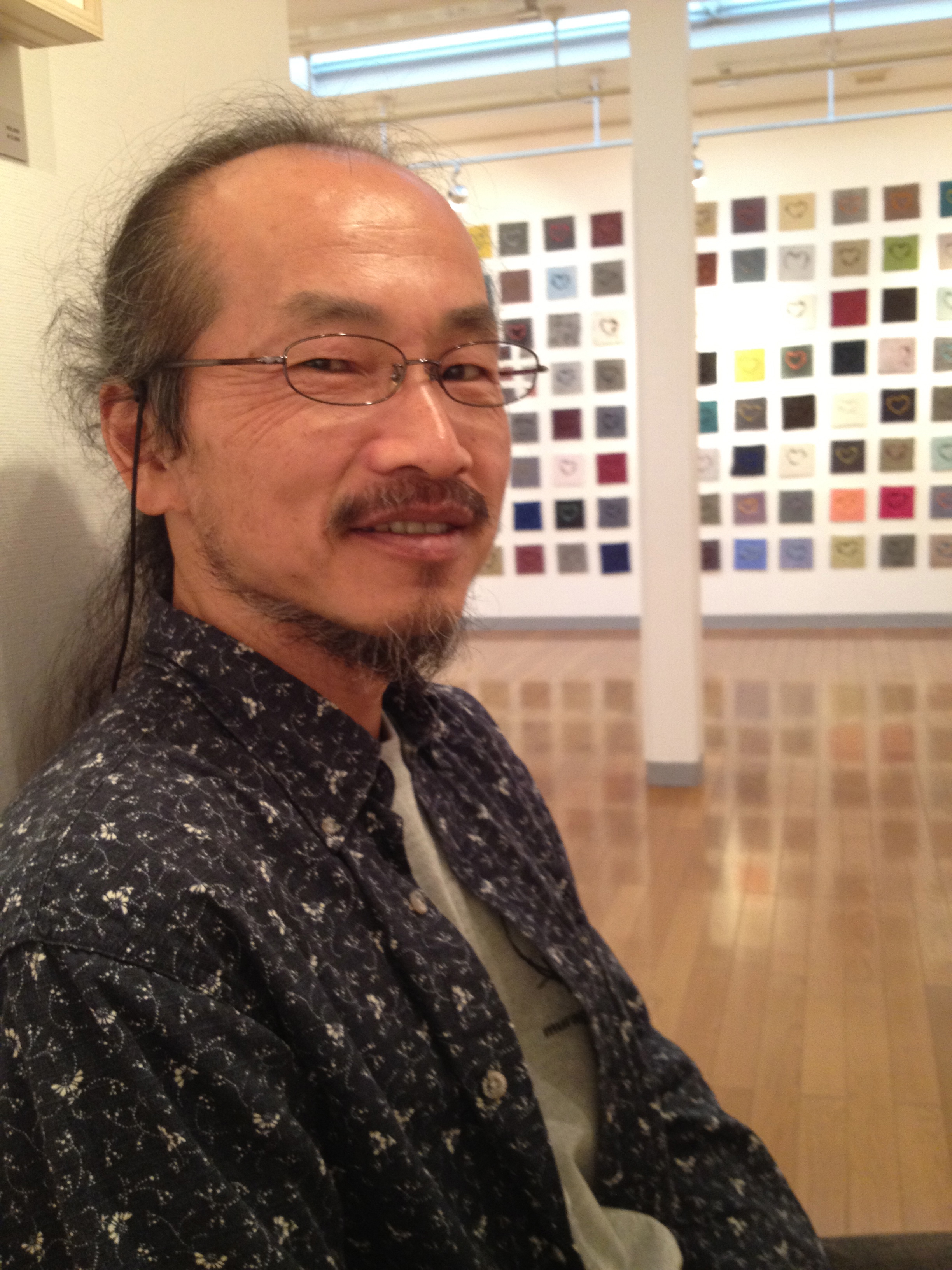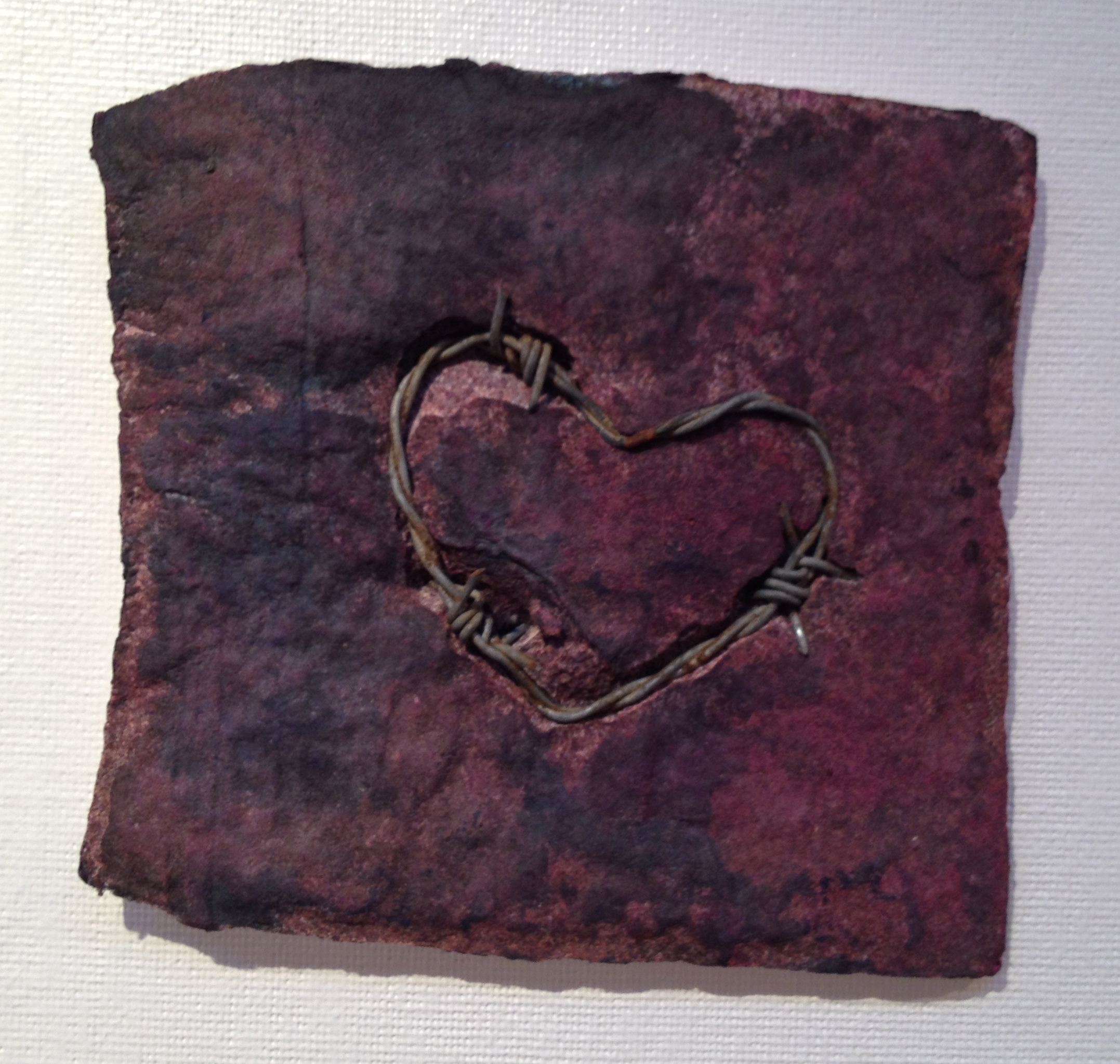
Toshihisa Fudezuka‘s stunning exhibition at Yoseido Gallery is untitled, but I would venture to give it one of my own –“Matters of the Heart.” Over the last two and a half years he has made about 500 handmade washi (Japanese paper) squares, each adorned with a barbed wire heart, culminating in this installation at Yoseido Gallery in Ginza.
 It’s always exciting when an artist takes a big step forward, especially when they move off the flat page and into more multi-dimensional space. Fudezuka’s earlier work was more traditional in technique, being mainly woodblock and etching, tending to focus on ambiguous moving objects, like clouds or water, in order to “initialize the human heart’s motion.” His viewpoint was more social and group oriented, and his works were meant to be ambiguous so that each person’s “ever-changing” heart would interpret them differently.
It’s always exciting when an artist takes a big step forward, especially when they move off the flat page and into more multi-dimensional space. Fudezuka’s earlier work was more traditional in technique, being mainly woodblock and etching, tending to focus on ambiguous moving objects, like clouds or water, in order to “initialize the human heart’s motion.” His viewpoint was more social and group oriented, and his works were meant to be ambiguous so that each person’s “ever-changing” heart would interpret them differently.
Fudezuka believes that a professional artist should provoke meaning from the human heart (their subject) through the use of an object (that which is portrayed). While he or she may embark upon the long path towards making their subject clear, once polished enough, they choose a new object. In these screen print over woodblock panels, with their barbed wire hearts, we see the emergence of his new theme.
The idea of thorns or barbs comes from the Japanese expression toge ga aru, whose colloquial meaning is negative, as in an unsutiable idea or intention to hurt. Fudezuka desires to turn the idea around and use it in the positive – instead of being pierced by the thorn, you can take it in and learn from it. It’s how you accept it and what you do with it. He has also chosen barbed wire as motif because it represents the borders between people and places and divides the viewer from the work. This detail from a large canvas-like woodblock print reads like shed handcuffs to me with the viewer left to pick their way through a no man’s land.
Fudezuka’s switch towards a new motif and medium occurred slowly over the last ten years as the tragedy of bad news, particularly that perpetrated by youth, began to affect his outlook on his work. He wanted to be more personal and individual and to use a simplistic object so that people would be sure to understand it. A heart shape is iconic and universal, representative and literal at the same time. It was almost against his own desire that Fudezuka chose it to be the medium of his message in fear of it being trite.
Learning to make the paper took Fudezuka about six months. He uses a square paper frame and mixes traditional Japanese fibers with western rags and cotton. The variety in the finish of the paper is broad. This one looks almost like stone…
…like cardboard…
…and like graphite.
While the paper is wet he places the barbed wire heart and leaves it to dry. Afterwards, he removes the heart to paint or stain it and the paper separately, reassembling them at the finish. For some, he deviates from the norm, either burying the metal heart under the paper…
…or working with broken or submerged pieces…
…or even a half heart.
Occasionally, he even changes the shape, like this spiral, to keep the viewer on their toes.
The variations are obviously there for artistic reasons, but also to represent the variations in individuals and their hearts. I found the exhibition to be both deeply thought-provoking and easily accessible (my 9-year-old loved it) at the same time. And the possibilities for display are endless – you could hang 1, a pair, 4 in a grid, 9 or a whole wall and so on…In person it felt quilt-like.
For those who have come to the exhibit and find it “too painful” Fudezuka has a special meishi (name card) for them with a band-aid on the back!
And if you are not familiar with Yoseido Gallery, you should be! It is the foremost print gallery in Tokyo, in operation since 1953, but actually stretching back historically in the same family and the same space for 140 years. Abe-san’s daughter Sue runs the gallery now, but her great-grandfather started the business as a screen and scroll mounting shop. Over the years, her grandfather and father even did work for the Emperor. In the 1950s Abe-san in consultation with Koshiro Onchi, one of the founding fathers of the hanga movement, changed the shop to a gallery representing modern Japanese art.
From the outside it is a small and fairly unassuming looking space, but inside there are drawers and folders full of treasures. It’s like going to the CWAJ Print Show whenever you want! Don’t be intimidated to ask to see anything – it is one of the most pleasant, no pressure gallery experiences to be had. Another Tokyo bucket list destination and for those who cannot come in person, an outstanding online catalog organized by artist, medium, color or subject is available.
Yoseido Gallery
5-5-15 Ginza,
Chuo-ku, Tokyo, JAPAN 104-0061
phone:03-3571-1312
Mon-Sat 11:00-19:00/Sunday&Holiday closed
Exit B5 from Ginza Station – on Namiki dori
Toshihisa Fudezuka’s exhibition runs until next Saturday, May 18th. I highly encourage you to stop in!













Great review!
I love this post–great interview. Will not miss Fudezuka’s touching exhibition. Will miss you though…
Yoseido is an excellent gallery, and Sue-san is delightful to work with. Contact them even if you are not in Japan. They make buying wonderful prints easy no matter where you are.